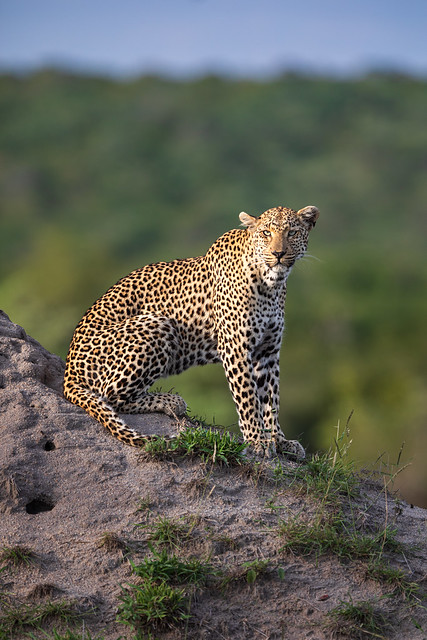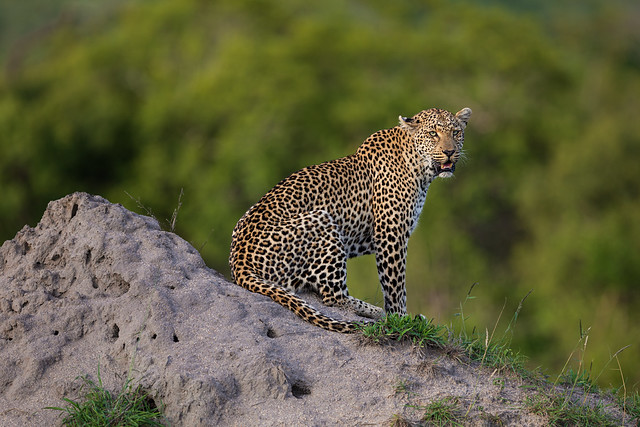It has been quite some time since I continued with my series of day-by-day articles, detailing our adventures during our epic time in Sabi Sand Wildtuin.
Precisely one year ago to this date, it was our seventh and final day in the bush for this particular trip. However, this article is about day five, which was an incredible day that brought amazing sightings, long-desired images, and unforgettable memories.
The morning began with a dramatic start.
One of the joys of staying in the African bush is the sounds of wildlife in the darkness of night. I had not been sleeping well — often waking much earlier than necessary — and at one stage, I heard the distinctive calls of hyenas. Judging by the volume of their vocalisations, they were not very far away. I fell asleep again, and was again woken by the hyenas, but this time they were very close.
It was around 4:30am, and I had a look through the door of our rondavel, and spotted hyenas on the front lawn, just metres away.
There was a commotion!
During the small hours, an impala had been killed, and it was right on the lawn outside the rondavels, a mere ten metres from our front deck.
Hyenas had arrived at the scene, with several lurking in the bushes in the lodge’s grounds. When it was safe, I proceeded outside and approached the deceased impala, capturing a photo of the hapless animal.
By now, Mario and several of the lodge’s guests had also congregated on one of the rondavel decks.
The hyenas were still lurking, and we were all amazed that such an event had taken place right on our doorsteps.
It is quite possible that a leopard had killed the impala. If so, then the leopard would have evacuated the scene, as hyenas are natural enemies of leopards and are known for intimidating leopards and stealing their kills.
We can never know whether the impala was killed where it was found, or whether the predator dragged it there; but wildlife does enter the lodge grounds, and during our stay, we saw a few bushbuck on the grounds. The leopard may well have chased this impala into the lodge, or otherwise stalked it.
Within a few minutes, one of the hyenas returned to the impala and dragged it away. The show was over.
The sun had not yet risen, and the day was already full of adventure.
Over our brief coffee start at the lodge with the guides and guests, there was certainly something interesting to discuss.
We soon headed out for the morning drive.
Within the early minutes of the drive, we spotted greater blue-eared starlings, a grey duiker, Egyptian geese and impala, before encountering three white rhinos grazing, north of the lodge.
As it is always special to see a rhino, we stopped and captured images as these critically endangered creatures grazed away in the dense bush.
After we had finished photographing the rhinos, Gabe headed off, and we had sightings of an African harrier hawk, guineafowl, steenbok, impala, a lone hyena on Elephant Plains Airstrip, and an African hoopoe.
Gabe headed east, where we encountered elephants, and stopped for a coffee break at a rocky outcrop overlooking the dry Marikeni River, which runs in a north-south direction to the east of the lodge.
In the distance to the south, on the western side of the river, was a lone white rhino!
While it was good to stretch the legs and sip some hot coffee, the opportunity to photograph a white rhino in its natural habitat was too good to miss, so I grabbed my gear and began photographing the rhino.
After our time spent with the rhino and some nearby elephants at a picturesque coffee stop location, we all climbed back into the 4WD, and Gabe headed south.
It was only a short while before we encountered our third special sighting of the day: female leopard Makhomsava!
As I related in the previous article in this series, chronicling day four, we encountered Makhomsava at twilight, and heard her catch and kill a scrub hare before dragging it up a tree and devouring it right in front of us.
Now we had the privilege of seeing Makhomsava for the second occasion during the week.
She was on a mission, and was constantly on the move. Photography was difficult as Makhomsava made her way through the dense bush on the eastern side of the dry Marikeni River, but I was fortunate to capture an image of her in the open, as she paused momentarily before continuing on her journey.
We spent over 30 minutes following and photographing Makhomsava before leaving her to it and heading back to the lodge.
Along the way, we spotted more elephants (including the Kruger research herd) and a black-headed heron, wading in a watering hole.
Back at the lodge, we all had breakfast, and I went through my usual routine of downloading and backing up our images from the morning drive.
While the day had been remarkable so far, there was more to come. After some discussions, the plan after lunch was for the three of us to head out on another game drive with Gabe and the two other guides: Doctor Mbhanyisi and Nicholas Greeff.
The purpose of the game drive was for us to discuss wildlife photography with the other guides and give them tips about light, angles, distances, composition, and positioning the safari vehicle for optimum photography.
It was an excellent opportunity to participate in an extra game drive, spend some quality time with these fantastic people, see more wildlife and maybe land the odd image or two. It was a special experience to be taken out for this unscheduled drive, purely because the other guides at Elephant Plains Game Lodge saw value in learning from us.
The shorter drive, during the intensity of the midday sun, brought us encounters with a large herd of breeding elephants at a watering hole, a tawny eagle and a water monitor.
While I have not published any images from that game drive yet, it looks like there may be some worth publishing.
After the drive, we returned to the lodge for some down time before the afternoon drive.
While the morning had been eventful, we had no idea what was in store for us for the afternoon.
Ready as always, we met Gabe at the front of the lodge, and climbed into the 4WD. We set off, heading north-west, spotting more impalas and a Wahlberg’s eagle as we made our way through the bush.
The magic was soon to begin: before we knew it, we had encountered the Tortoise Pan male leopard!
This was our second encounter with Tortoise Pan, a large, experienced leopard who was born into the Londolozi Royal Family of leopards in 2016. When we encountered him, he showed the signs of having been in a reasonably recent battle with possibly another leopard.
As has been the case so far, the Sabi Sand leopards that we had encountered had all been on the move, which not only made photography difficult, but it had also made it difficult to keep up with the big cats.
Fortunately for us, Tortoise Pan did stop on occasion in open places, allowing us a brief window of time to capture images of him before he resumed moving throughout the bush.
We only spent a few minutes with Tortoise Pan, as something special was happening nearby.
Perhaps only a hundred or so metres south, female leopard Tiyani was resting on a mound in the warmth of the afternoon sun.
Gabe took us to where Tiyani had been found, at which point we were amongst several other 4WD vehicles which had arrived for this special sighting.
To see a leopard resting on a mound in the open, set against a clean, distant background and bathed in the warmth of late afternoon light, is a delight for photographers who love to photograph leopards. All of the ingredients are there:
- a relaxed leopard who is not going anywhere, is not moving much, and is likely to look towards the camera;
- extra subject height due to the mound, which is great for photographing the leopard at eye-level rather than looking down on it;
- substantial distance between the leopard and the background, which allows for subject isolation and a clean backdrop; and
- warm light, which can elevate any subject to another level.
We had it all. It was the first time, in four trips to Africa, that I had the opportunity to capture the type of image that I wanted, and I achieved it.
Here is Tiyani, basking in the afternoon sun:
To say that our excitement level was high would be under-stating the matter somewhat. This was an exceptional sighting, and everyone at the scene was treated to a real delight.
After spending some time photographing Tiyani from our initial position, Gabe decided to move the vehicle further around for a different angle. This was the resulting view of this amazing leopard:
Tiyani spent time looking around, and periodically looked towards us. As soon as a wild animal — especially a leopard — looks towards photographers, the rapid fire of camera shutters erupts. Everyone wants the eye contact shot.
We spent around 15 minutes at the scene, before Tiyani decided to move on.
What a sighting!
It was time for us to move on, too. We headed south, encountering some hippos at a watering hole, before happening upon a red-billed hornbill south of the lodge.
I saw a fantastic opportunity, and I asked Gabe to stop. To my surprise, I was the only one who wanted to capture images of the hornbill.
We spent literally a minute at the scene, as I fired off many shots of the hornbill, which was photogenically positioned amongst a clean setting.
This was the result:
I am sure glad that we stopped, as this is one of my favourite images of a wild bird.
After I had concluded, we departed, spotting some female waterbucks in the open, as well as zebras a wildebeest, impala bucks and a few other species of wildlife along the way for our sundowner.
The sky decided to put on a show, which made for a fantastic closure to yet another special day in Sabi Sand Wildtuin.
As we stopped for our sundowner, we all took in the splendour of the light show that was unfolding before our eyes.

Sundowner on Sabi Sand Wildtuin Safari Night 5
Look at those colours!

Magical Sabi Sunset
Our fifth day had been magical, with sightings of two species from the big five of Africa. We had two encounters with the endangered white rhino; we encountered three unique leopards in Makhomsava (our second sighting), Tortoise Pan (also our second sighting) and Tiyani (our fifth sighting); we were treated to an extra game drive with Gabe, Doctor and Nick; we saw many species of African wildlife; I captured a very pleasing image of a red-billed hornbill; we finally landed the iconic ‘leopard on a mound’ image; and we closed off the afternoon drive with a spectacular sunset.
While it has taken a long time for me to sit down and tell the story of day five, stay tuned for our adventures on day six, which also brought us fantastic sightings and experiences.








Pingback: What Makes a Great Safari? | Xenedis Photography